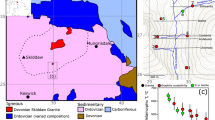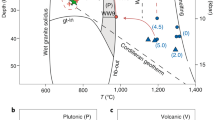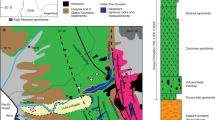Abstract
ONE of the principal ways in which continental crust grows is by the incorporation, from deeper within the Earth, of large volumes of granitic magma. A 'space problem' exists1 as to how these magmas are accommodated in the crust. Traditionally two main emplacement mechanisms have been emphasized: 'forceful' intrusion, whereby buoyancy-driven magmas physically push the crust aside, creating granitic diapirs and balloons; and 'passive' emplacement characterized by replacive mechanisms such as cauldron subsidence and stoping. Although more recent work2,3 has demonstrated that space for granites may be created within bends and offsets of large transcurrent faults, the simple view of either forceful or passive still fails to account for the intrusive mechanisms of many granites. Here we report the discovery of a new igneous intrusion mechanism. In the superbly exposed Proterozoic continental crust of South Greenland we have observed that rapakivi granite was intruded as large-scale sheets along ductile extensional shear zones that were active during emplacement. In such a process the space problem seems to be simply resolved.
This is a preview of subscription content, access via your institution
Access options
Subscribe to this journal
Receive 51 print issues and online access
$199.00 per year
only $3.90 per issue
Buy this article
- Purchase on Springer Link
- Instant access to full article PDF
Prices may be subject to local taxes which are calculated during checkout
Similar content being viewed by others
References
Read, H. H. Mem. geol. Soc. Am. 28 (1948).
Hutton, D. H. W. J. geol. Soc. Lond. 139, 615–631 (1982).
Castro, A. J. J. struct. Geol. 8, 633–645 (1986).
Elliston J. N. Earth Sci. Rev. 2, 1–92 (1985).
Bridgwater, D. & Windley, B. F. Spec. Publs geol. Soc. S. Afr. 3, 307–316 (1973).
Allart, J. H. in The Geology of Greenland (eds Escher, A. & Watt, W. S.) 120–151 (Grønl. Geol. Unders., city, 1976).
Gulson, B. L. & Krogh, T. E. Geochim. cosmochim. Acta. 39, 65–82 (1975).
Sutton, J. & Watterson, J. Rapp. Gronlands, Geol. Unders. 15, 58–60 (1968).
Simpson, C. J. struct. Geol. 7, 503–511 (1985).
Blumenfeld, P. & Bouchez, J.-L. J. struct. Geol. 10, 361–372 (1988).
Hutton, D. H. W. Bull. geol. Soc. Am. 100, 1392–1399 (1988).
Hutton, D. H. W. Trans. R. Soc. Edinb. 79, 245–255 (1988).
Pitcher, W. S. & Berger, A. R. The Geology of Donegal: A Study of Granite Emplacement and Unroofing (Wiley, London, 1972).
Wernicke, B. & Burchfield, B. C. J. struct. Geol. 4, 105–115 (1982).
Gibbs, A. D. J. geol. Lond. 141, 609–620 (1984).
Gibbs, A. D. Spec. Publs. geol. Soc. Lond. 28, 19–33 (1987).
Hossack, J. R. J. geol. Soc. Lond. 141, 629–637 (1984).
Bridgwater, D., Sutton, J. & Watterson, J. S. Tectonophysics 21, 57–77 (1974).
Author information
Authors and Affiliations
Rights and permissions
About this article
Cite this article
Hutton, D., Dempster, T., Brown, P. et al. A new mechanism of granite emplacement: intrusion in active extensional shear zones. Nature 343, 452–455 (1990). https://doi.org/10.1038/343452a0
Received:
Accepted:
Issue Date:
DOI: https://doi.org/10.1038/343452a0
This article is cited by
-
Geochemical characterization and zircon U–Pb geochronology of the Tirodi Gneissic Complex, Central Indian Tectonic Zone (CITZ): constraints on petrogenesis, Proterozoic crustal evolution and tectonic setting
Mineralogy and Petrology (2024)
-
Geochemistry and petrogenesis of the Paleoproterozoic ortho-gneisses and granitoids of the Banded Gneissic Complex, central Rajasthan, NW India: Implications for crustal reworking processes
Acta Geochimica (2023)
-
Emplacement levels and pre-existing structures control mechanisms and host rock interactions of three granitic plutons, western Arabian Shield
International Journal of Earth Sciences (2019)
-
A Palaeoproterozoic multi-stage hydrothermal alteration system at Nalunaq gold deposit, South Greenland
Mineralium Deposita (2017)
-
Tectonic imprints within a granite exposed near Srinagar, Rajasthan, India
Journal of Earth System Science (2014)
Comments
By submitting a comment you agree to abide by our Terms and Community Guidelines. If you find something abusive or that does not comply with our terms or guidelines please flag it as inappropriate.



